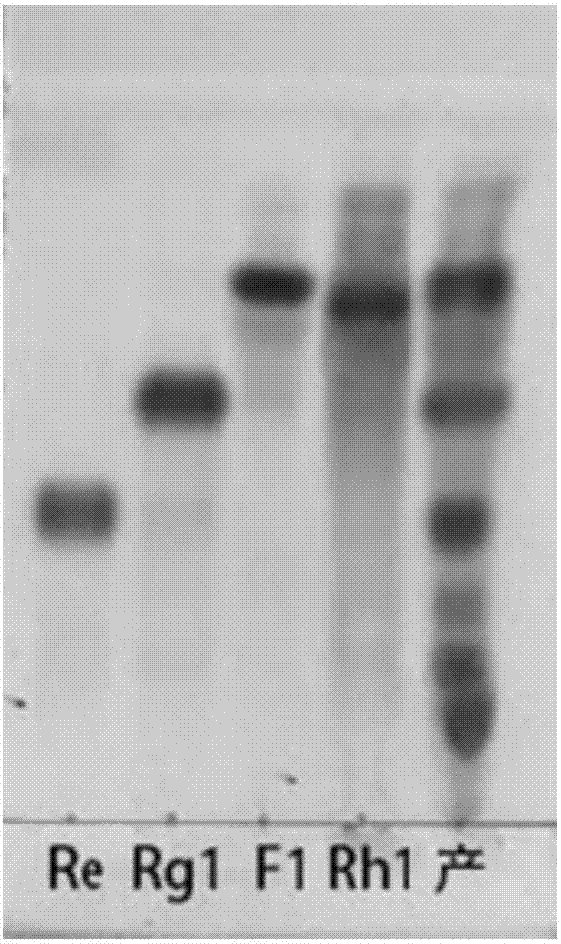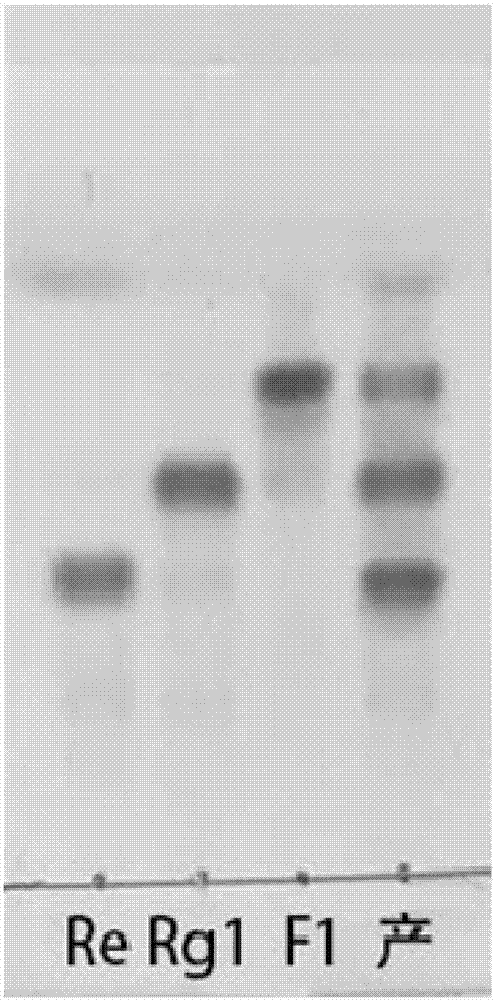Preparation method and application of high-activity anti-aging component with natural source
A natural source, anti-aging technology, applied in the field of ginsenosides, can solve the problems of high production cost, cumbersome process, and complicated products, and achieve the effect of low production cost and few process steps
- Summary
- Abstract
- Description
- Claims
- Application Information
AI Technical Summary
Problems solved by technology
Method used
Image
Examples
preparation example Construction
[0065] A method for preparing natural-derived high-activity anti-aging ingredients is carried out according to the following steps:
[0066] 1) Screen a single aerobic strain that can produce triol ginsenoside hydrolase;
[0067] 2) Select the plant tissue of the genus Ginseng as the main raw material, and add at least one of wheat bran, wheatgrass, grain flour, and an appropriate amount of inducer; stir well and add an appropriate amount of water; the water content of the solid medium after stirring is uniform Between 30 and 70%;
[0068] 3) After mixing, quickly heat to above 100°C and keep it for 2-30 minutes for sterilization, and then quickly cool to below 45°C; after sterilization, insert the strains, which are the only bacteria, molds and yeasts One, the inoculation amount is 0.001% to 50% of the total weight of the culture medium; the culture medium is fully stirred by rotating the fermentor, and sterile air is introduced; warm water is introduced into the interlayer of the ...
Embodiment 1
[0075] First prepare fermented bacteria seeds: take 100g of ginseng stems and leaves and crush them to about 10 mesh, mix with 900g of wheat bran, add 1L of water, stir evenly, put into a triangular flask, sterilize at 120°C for 20 minutes, and then join the research team after cooling A selected Aspergillus oryzae (Dongming Wang, Process Biochemistry, 2012, 47(1), 133-138), cultured at 28°C for 7-8 days, is the fermented seed.
[0076] Large-scale fermentation in a fermenter: crush 30kg ginseng stems and leaves to about 10 meshes, add 50kg wheat bran, 5kg soybean meal, and 80kg water to mix evenly, put them into the fermenter, steam to 100℃ for sterilization, 12 minutes later, cool To 35°C, then insert the prepared seeds for fermentation culture. Filtered sterile air is always introduced during the cultivation process, the temperature of the fermenter interlayer is set to 30°C, the temperature is kept for 24h, and then the product temperature is always kept between 28-30°C, and ...
Embodiment 2
[0078] The fermented seeds were prepared according to the method in Example 1.
[0079] Take 20kg American ginseng fibrous root, crush it to 10-20 mesh, mix it with 70kg wheat bran and 10kg Sophora japonica, mix it with 50kg water, stir evenly, put it into the fermenter, heat it with steam to 100℃ for 10 minutes, and quickly cool it to 40℃. Then insert the seed. Sterile air is always introduced into the fermenter, and the temperature of the interlayer is set to 30℃. After keeping the temperature for 24 hours, keep the product temperature between 28~30℃. After 12 days of fermentation, the fermentation product is rich in F1, such as figure 2 Shown.
[0080] Then add 500L methanol to the fermentor, extract 3 times at 50℃, 3h each time, concentrate the extract under reduced pressure at 25~70℃, -0.01Mpa~1Mpa until there is no methanol residue, add 50L cyclohexane for degreasing twice, Put the degreased solution on a 30LAB-8 macroporous adsorption resin column, and repeatedly load the...
PUM
 Login to View More
Login to View More Abstract
Description
Claims
Application Information
 Login to View More
Login to View More - R&D
- Intellectual Property
- Life Sciences
- Materials
- Tech Scout
- Unparalleled Data Quality
- Higher Quality Content
- 60% Fewer Hallucinations
Browse by: Latest US Patents, China's latest patents, Technical Efficacy Thesaurus, Application Domain, Technology Topic, Popular Technical Reports.
© 2025 PatSnap. All rights reserved.Legal|Privacy policy|Modern Slavery Act Transparency Statement|Sitemap|About US| Contact US: help@patsnap.com



